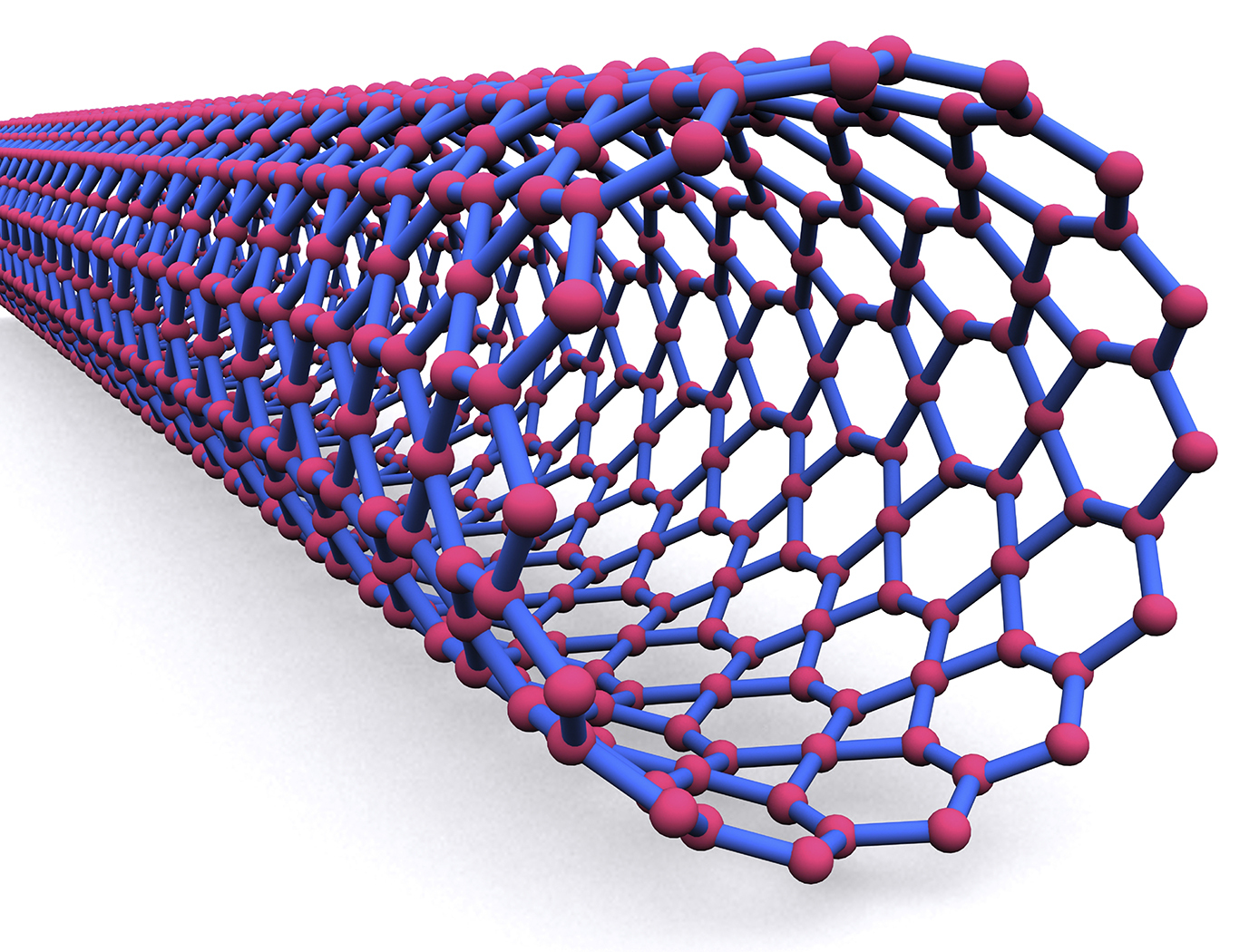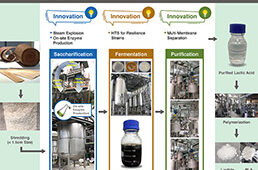Contaminant-free steel, an engineered matrix self-healing composite, and a Shape Memory Alloy Rock Splitter —just a few of the recent materials innovations emerging from NASA’s Glenn Research Center in Cleveland. New discoveries are in the process of being patented, and many technologies are already available for licensing by industry through NASA’s Technology Transfer Program. Glenn has a strong history of research in materials science, developing alloys, coatings, composites, and cutting-edge materials as well as the processes involved. Examples of these technologies are presented here.
Material/process development
Glenn researchers have developed a process to create contaminant-free steels. These steels never come into contact with ceramic or oxygen during their production, thus eliminating the threat of impurities acting as stress concentrators that lead to component failure. Elementally pure constituents are melted together, solidified, and then atomized; the resulting powder is pressed into a fine-grained ingot. This process can produce highly pure and reliable steel products such as bearings, gears, and cutting tools as well as equipment for use in aerospace, nuclear power, and oil drilling.
 370 Resin for High-Termperature Applications.jpg)
Resin Transfer Molding (RTM) 370 Resin for High-Temperature Applications. Photo Provided by NASA Glenn
Glenn innovators have also developed Resin Transfer Molding resin RTM370 for high-temperature applications. This resin is generated from commercially available precursors using a revolutionary, yet low-cost, solvent-free process. Composites can be made-up from RTM370 using a variety of injection methods or by making the resin powder into a fibrous material used to make reinforced plastics. Lightweight carbon-fiber/RTM370 components can be printed using laser sintering and have potential to replace metallic parts in several applications. This technology won an R&D 100 Award in 2017.
Coatings
Glenn has developed a cutting-edge environmental barrier coating (EBC) system to protect high-temperature silicon-based ceramics and ceramic-matrix composite components. The EBC system uses a novel bond coat that offers thermal and environmental protection and a ceramic top coat. The bond coat comprises doped silicon alloys and stable oxide- and silicate-based materials. The top coat uses multicomponent hafnium and rare-earth silicates, imparting improved mechanical properties and corrosion resistance along with low oxygen and water permeability. The many possible applications of this EBC system include gas turbine engines, nuclear reactors, heat exchangers, and furnaces.
A new coating at Glenn has also been synthesized to protect machinery: a revolutionary solid lubricant composite comprising a metallic binder, a metal-bonded oxide hardener, and a high- and or low-temperature lubricant. These ingredients allow the composite to perform in extreme temperatures—from cryogenic to >900 °C—and provide additional hardness, wear resistance, and thermal stability as well as low friction. Called PS400, the composite coating can be plasma sprayed onto a metal surface and easily ground (e.g., with SiC). If a coating is not feasible, the powder metallurgy composite, called PM400, can be used to fabricate components.
Composites
Glenn researchers have devised a composite technology to improve the properties of SiC/SiC composites. Fabricated by slurry casting and melt infiltration, the engineered matrix offers increased crack resistance because it is able to withstand more load at high temperatures (³2700 °F) and prevent cracks from propagating, thus taking some of the load off the fibers. The matrix can also “self-heal” by converting the oxygen found within to low-viscosity oxides, which fill fine cracks to extend the life of the material. These lightweight materials are designed to replace nickel-based superalloys for high-temperature, high-stress applications, such as components for heat exchangers, nuclear reactors, and turbines in aircraft and power-generation equipment.

Carbon Nanotubes. Photo Provided by NASA Glenn
Nanomaterials
Glenn is at the forefront in the development of new, cutting-edge materials. Recent breakthroughs include a new process that treats hexagonal boron nitride (hBN) to create nanolayered BN materials that have no impurities or structural damage. hBN-alumina nanocomposites have been created as well. Because these novel, lightweight nanomaterials are electrically insulating and thermally conductive, they have potential use in applications such as microelectronic devices, radiation shielding, and energy harvesting.
Glenn researchers have also developed a new technique to add oxygen to carbon nanotubes via photo-oxidation. Single-wall carbon nanotubes (SWCNTs) have many properties superior to carbon fiber, and oxidizing them would increase their ability to be incorporated in polymer matrices, which greatly improves the polymer’s mechanical, electrical, and thermal properties. This technique may also be applied to multi-wall carbon nanotubes and graphene, and the materials have potential for aircraft, automotive, and sporting goods applications.
Aerogels
Aerogels are the world’s lightest solid materials—roughly 85 percent is air. Glenn aerogel research may soon find its way into a host of everyday items, from insulation to antennas to windshields.
Using a unique crosslinking approach, Glenn has synthesized polyimide aerogels that are highly flexible and 500 times stronger than conventional silica aerogels. They can be molded or machined into parts that are stiff, or cast as flexible films that have good tensile properties. Potential applications include thermal insulation, automotive and aircraft structures, antennas, filtration media, and protective clothing.
Glenn has also developed optically transparent polyimide aerogels (refractive index close to 1) that are not only lightweight, but strong and flexible. They possess low thermal and acoustic conductivity and are able to maintain their properties in demanding environments. These aerogels are made with a sol-gel process from aromatic dianhydrides and diamines. Additives enable the aerogel to be made into blocks or films. Potential uses include acoustic and thermal insulation, windshields, windows, antennas, and optical sensors.
Shape Memory Alloys
Glenn is also doing exciting research in shape memory alloys (SMAs). Before being put into use, SMAs must be “trained” to return to their previous form when heated. Researchers at Glenn have developed a new way to do this in much less time at low cost. This revolutionary technique, using mechanical cycling under fixed temperature, achieves stabilization in minutes, making SMAs more practical to use in fields such as aerospace, aviation, automotive (frame, engine mounts, suspension), household (appliance fasteners and seals), and medical (stents, bone repair, robotics).
Researchers at Glenn have invented a Shape Memory Alloy Rock Splitter (SMARS), a device that eliminates the need for explosives by using SMAs composed of NiTiHf and/or NiTiZr. To split rock, a hole is drilled into the rock and the compressed SMA actuating member is placed there. Current energizes a heater at the SMA, which expands once the transition temperature is reached; this exerts up to 1500 MPa to split the rock. When the current is stopped and the heater cools, the SMA returns to its original size and is removed, ready to be used again. SMARS provides high-powered rock fracturing that is controllable without using explosives.
More information on these and other materials technologies at the NASA Glenn Research Center can be found at https://technology.grc.nasa.gov/materials_and_coatings/1. To learn more about licensing a NASA Glenn technology, visit the Technology Transfer Program website at https://technology.grc.nasa.gov/.




